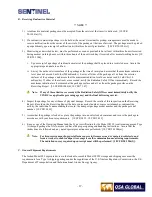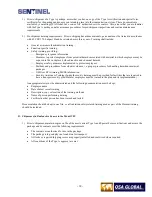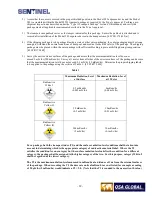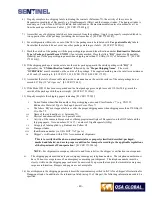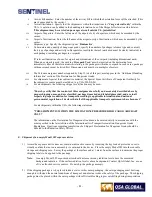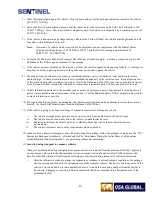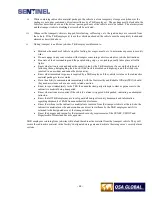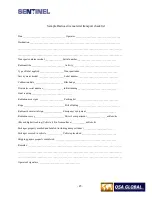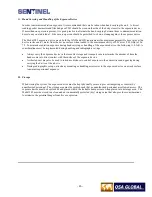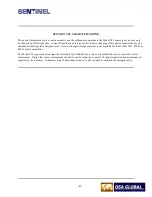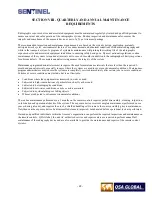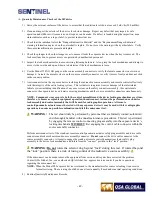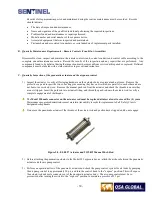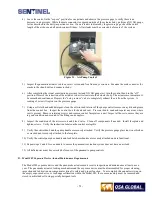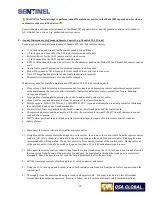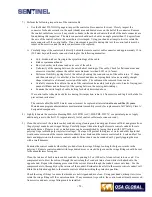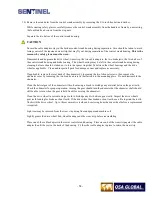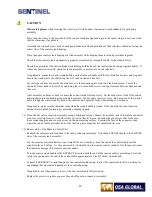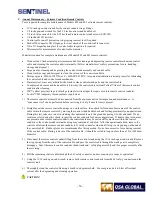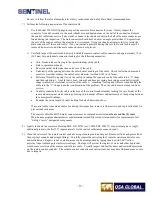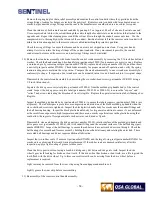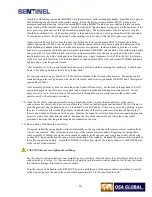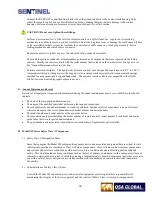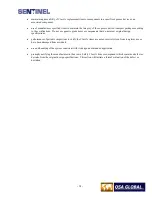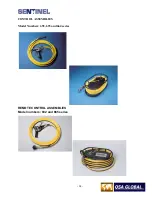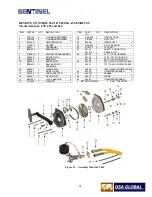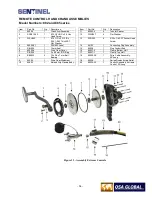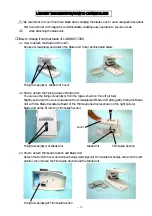
- 49 -
A.
Quarterly Maintenance Checks of the 989 device
1)
Survey the external surfaces of the device to assure that the radiation levels do not exceed 2 mSv/hr (200 mR/hr).
2)
Clean and inspect the exterior of the device for obvious damage. Report any defect that may impair its safe
operation and withdraw it from service until repairs can be made. If a defect is found during the inspection, use a
status indicator, such as a tag or label, to prevent inadvertent use.
3)
Check that the radiation trefoil, the “Danger Radioactive Material” and the “Rayonnement Danger Radiation”
warning information engraved on the outer shell is legible. Do not cover the warning with any other labels. Verify
the source identification is present and legible.
4)
Check the plunger lock on the storage cover to ensure it locks the exposure device when the key is removed. The
lock must function to prevent access or operation by unauthorized personnel.
5)
Inspect the lock mechanism for loose or missing fastening hardware. Also, grasp the lock mechanism and attempt to
move it side -to-side and up-and-down to determine if the lock mechanism is loose.
6)
Use the Model 550 NO GO gauge on the source assembly connector to verify the female connector is not worn or
damaged. Actuate the movable sleeve on the source assembly connector to verify it moves freely and does not stick
in the connect position.
7)
A misconnect test on the exposure device including the radioactive source assembly and remote controls effectively
tests the integrity of the entire locking system. This test detects long term wear (or damage) of the interrelated
failsafe system including identification of any excess wear on the safety connector assembly, the control male
connector, the exposure device automatic securing mechanism and the source assembly connectors simultaneously.
NOTE: Component wear occurs to both the control assemblies and the device locking mechanisms over time,
therefore, to ensure acceptable equipment operation, the misconnect test must be performed on each device
lock assembly and control assembly that will be used for radiographic operations. All remote
controls/pneumatic actuators must be tested with any exposure device it may be used with for radiographic
operations to ensure no possible combination could fail the misconnect test.
WARNING:
The test should only be performed by personnel that are formally trained, authorized
and thoroughly familiar with annual maintenance procedures. This test is performed
by engaging the remote control connecting plug assembly into the exposure device’s
locking mechanism
WITHOUT
first engaging the control cable connector within the
source assembly connector.
Perform a misconnect test of the crank-out remote control/pneumatic actuator safety plug assembly and drive cable
connector and lock mechanism and source assembly connector.
Do not
connect the drive cable connector to the
source assembly connector. Attempt to engage the crank-out remote control/pneumatic actuator safety plug
assembly to the device lock mechanism, and rotate from the “connect” position to the “lock” position.
WARNING:
Do not
rotate the selector ring beyond “lock” during this test. If rotated beyond
the “lock” position, there is a risk of losing control of the radioactive source assembly.
If the misconnect can be made, remove the equipment from service until repairs have corrected the problem.
Contact QSA Global, Inc., or an authorized QSA Global, Inc. approved service center if you have questions
regarding the misconnect test.
NOTE:
When the Model 989 exposure device is returned to the manufacturer for source reloading it can receive
formal servicing. The servicing should be done at least annually if used under normal operating conditions.
8)
Routine Quarterly Maintenance Records
Summary of Contents for 989
Page 1: ...MAN 037 October 2017 ...



